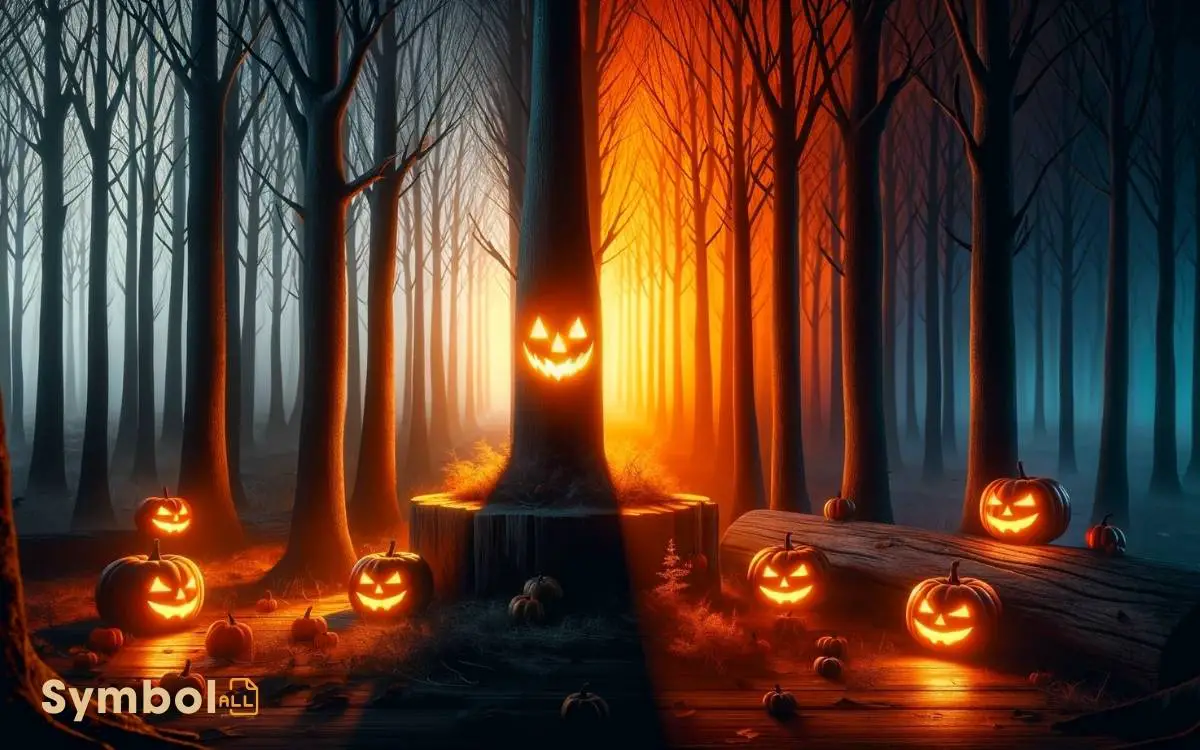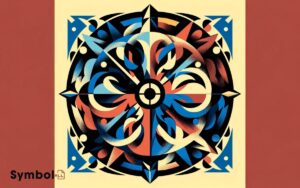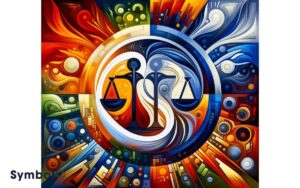What Do the Halloween Colors Black and Orange Symbolize?
You’re embracing a blend of history and symbolism when you use black and orange in your Halloween decor. Black captures the essence of night, mourning, and the domain of the dead.
It reminds you of the longer nights and the chilling embrace of winter, marking a time when the veil between life and death thins. Orange, on the other hand, bursts with the vitality of the harvest, warmth, and the enduring spirit of life through the cold.
It reflects the fire’s protection against the darkness, guiding spirits to safety. Together, these colors capture the cyclical nature of life and death.
There’s much more beneath the surface of these traditions, hinting at an intricate tapestry of beliefs and practices that have shaped Halloween.

Key Takeaways
The Origins of Halloween
Tracing back to ancient Celtic festivals, particularly Samhain, Halloween’s origins reveal a deep connection to rituals marking the end of the harvest season and the onset of winter.
You’ll find that this period wasn’t just a time for celebration but a pivotal moment for the Celts, who believed the boundary between the living and the dead became blurred on the night of October 31st.
This belief paved the way for the modern Halloween, where costumes and festivities are designed to ward off roaming spirits.
Analyzing these ancient practices, you recognize how they laid the groundwork for the holiday’s current themes of change, reflection, and commemoration.
Understanding this historical context enriches your appreciation of Halloween, highlighting its significance beyond mere seasonal entertainment.
Historical Significance of Black
Building on our understanding of Halloween’s origins, let’s explore the historical significance of black, a color deeply intertwined with the holiday’s themes of mortality and the spirit world.
Historically, black signifies the absence of light and, by extension, life itself. In many cultures, it’s the color traditionally associated with mourning and death, embodying the void left by the departed.
During Halloween, this symbolism is magnified, reflecting the thin veil between the living and the dead that the holiday represents. It’s a visual reminder of the dark, longer nights that begin to envelop the Northern Hemisphere as autumn progresses.
Black’s pervasive use during Halloween isn’t just for spookiness; it’s a profound nod to the cycle of life and death, anchoring the holiday’s roots in ancient traditions that honor the dead.
Historical Significance of Orange
Orange, with its vibrant hue, captures the essence of fall’s bounty and signifies the shift and conversion inherent in the season, deeply enriching Halloween’s palette with historical and cultural layers.
- Harvest Celebration: Traditionally, orange symbolizes the harvest, a critical period before winter’s scarcity.
- Endurance and Strength: It reflects the endurance of life through the cold months, embodying strength and resilience.
- Fire and Warmth: The color also represents fire’s warmth, guiding spirits and providing protection.
- Festivity and Joy: In many cultures, orange is a color of joy and celebration, fitting for a festival that marks the end of harvest.
- Change and Adaptation: It signifies transformation, mirroring nature’s shift and encouraging adaptation to new cycles.
Understanding orange’s multifaceted role deepens the appreciation of its significance in Halloween’s tradition.
Black: Symbol of Death
While orange captures the vibrancy of harvest, black explores the darker, more somber aspects of Halloween, symbolizing death and the afterlife.
This stark color mirrors the night’s sky, a vast, unknowable space that has long been associated with the unknown, including what lies beyond this life.
In the context of Halloween, black doesn’t just represent the end of life but also the mysteries that death encompasses. It’s a color that invokes the eerie, the hidden, and the solemn remembrance of those who’ve passed.
Orange: Symbol of Harvest
Shifting focus to the brighter side of Halloween, the color orange captures the essence of harvest, embodying the warmth and abundance of the autumn season.
This vibrant hue symbolizes:
- The bountiful crops ready for gathering
- Warmth of the fading sun, offering comfort as days grow shorter
- Shift from the lush green of summer to the rich, golden tones of fall
- Celebration of abundance and gratitude for the earth’s generosity
- Connection to the natural cycle of growth, harvest, and renewal
Orange, in its essence, invites you to appreciate the bounty and beauty of nature’s gifts. It’s a reminder of the cycles of life, encouraging reflection on growth, harvest, and the importance of nurturing the earth that sustains us.
The Night and Its Mysteries
Why does the night, with its deep shadows and whispered secrets, hold such a pivotal role in the celebration of Halloween?
It’s because the veil between our world and the supernatural seems thinnest under the cover of darkness. Historically, Halloween is tied to the end of the harvest season, a time when the boundary between the living and the dead was believed to blur.
The night, in its infinite mystery, becomes a canvas for our deepest fears and curiosities about the unknown. It’s a time when ghosts, spirits, and otherworldly entities are said to roam freely, making their presence felt.
This ambiance of mystery and anticipation is why the night is essential to Halloween’s allure. It invites us to explore, even if tentatively, the mysteries that lurk in the shadows.
Fertility and the Harvest Season
Exploring further, the significance of Halloween also extends to its roots in fertility and the harvest season, marking a period when the earth’s bounty was celebrated and feared for its abundance and the impending winter scarcity.
This time was critical for communities dependent on agrarian cycles, reflecting both hope and anxiety about the future.
- The harvest’s end signaled a time to take stock of resources.
- It was a moment when fertility rituals were prominent, ensuring the land’s productivity for the next year.
- Celebrations often included feasting on the season’s crops.
- Symbolic representations of fertility, like cornucopias, were widespread.
- The period also marked a time to honor deities associated with harvest and fertility, intertwining spiritual beliefs with agricultural practices.
Understanding this background adds depth to why harvest colors are so integral to Halloween’s palette.
Protection Against Darkness
As you explore the symbolism of Halloween, it’s important to understand how colors function as a bulwark against the dark.
The tradition of warding off evil spirits with specific hues taps into a deep, cultural vein of seeking symbolic nighttime safety.
These practices, rooted in ancient protective traditions, offer a fascinating glimpse into how fear and protection have been intertwined and visually represented through time.
Warding Off Evil Spirits
One often overlooks the powerful role that colors play in warding off evil spirits, especially during Halloween, where specific hues serve as protectors against darkness.
The colors black and orange aren’t just decorative; they’re steeped in tradition and meaning, acting as a shield against the unseen.
- Black symbolizes the veil between the living and the dead, creating a barrier.
- Orange represents warmth and fire, elements believed to repel malevolent spirits.
- Combining black and orange in decorations forms a potent symbol of protection.
- Candles and lanterns often accompany these colors, enhancing their effect.
- Costumes and masks in these hues are thought to confuse or frighten spirits away.
Understanding these colors’ roles enriches the Halloween experience, offering not just fun but a connection to ancient practices of safeguarding one’s home and family from the ethereal.
Symbolic Nighttime Safety
Fascinatingly, the tradition of using specific colors for protection doesn’t end with warding off spirits; it extends into ensuring safety during the dark hours of Halloween night.
The color orange, vibrant and highly visible, serves as a beacon of light in the night, guiding trick-or-treaters and party-goers. It symbolizes the warmth of fire, a historical source of protection against the unseen dangers lurking in the dark. It also evokes the crispness of autumn, with pumpkins and falling leaves painting the world in shades of amber and gold. Beyond its seasonal associations, the meaning of orange in scripture often conveys themes of endurance, strength, and the enduring light of faith. This duality of warmth and resilience makes orange a color that transcends mere aesthetics, carrying profound significance across cultures and traditions.
On the other hand, black, embodying the darkness of the night, reminds individuals to remain cautious and vigilant. This strategic use of color not only enriches the Halloween experience but also embeds a layer of safety within the celebration.
It’s a thoughtful continuation of ancient practices adapted to modern festivities, where symbolism and practicality intertwine seamlessly.
Ancient Protective Traditions
Delving into the past reveals that ancient civilizations implemented a myriad of practices to shield themselves from the enigmatic threats that darkness was believed to harbor.
These traditions, deeply rooted in the fear and respect for the unseen, weren’t only about survival but also about asserting control over the unpredictable.
- Lighting Bonfires: To ward off evil spirits and illuminate the night.
- Carving Protective Symbols: On doorways and around settlements as a safeguard.
- Wearing Amulets: Believed to offer personal protection against the supernatural.
- Ritualistic Chanting: To banish darkness and call forth light.
- Herbal Brews: Consumed or sprinkled around homes for their purifying properties.
These practices underscored a profound understanding: that the veil between the natural and supernatural thinned during times of darkness, necessitating active measures for protection and safety.
Celebrating the Cycle of Life
As you explore the symbolism of Halloween colors, it’s critical to understand their role in celebrating the cycle of life, encompassing both mortality and rebirth.
The vibrant oranges and deep blacks you associate with this holiday represent not just the shift from autumn to winter but also the constant interplay between life and death.
This duality serves as a reminder of the natural order, where endings are merely precursors to new beginnings.
Seasonal Transition Representation
Halloween’s vibrant colors symbolize the cyclical shift from life to death and rebirth, celebrating the unchanging rhythm of the seasons. This period highlights the natural balance and the importance of changes in the cycle of life.
As you explore the symbolism, you’ll notice:
- Orange represents the harvest, the pinnacle of life and nourishment.
- Black contrasts this by signifying the longer nights and the encroaching winter.
- Together, they encapsulate the essence of autumn, a time of both abundance and preparation for dormancy.
- These colors remind us of nature’s impermanent, yet predictable patterns.
- They urge us to embrace change, reflecting on how adjustments are essential for growth and renewal.
Understanding these symbols enriches your appreciation of Halloween, linking festivity to the profound cycles of the natural world.
Mortality and Rebirth
In exploring the cycle of life, Halloween vividly celebrates the intertwined themes of mortality and rebirth, inviting you to reflect on the impermanence and renewal inherent in our existence.
This festivity, deeply rooted in ancient traditions, symbolizes the end of the harvest season and the onset of winter, representing death in its natural cycle.
Yet, it’s not merely an end but a segue into the concept of rebirth. The vibrant orange, reminiscent of autumn’s foliage, and the stark black, symbolizing the longer nights, serve as metaphors for this cycle.
They encourage you to acknowledge the transient nature of life while celebrating the potential for regeneration and new beginnings.
Halloween, hence, offers a profound commentary on life’s perpetual rhythm, emphasizing that from death comes life anew.
The Power of Fire
Fire’s warmth and allure, embodying transformation and renewal, plays a pivotal role in the tapestry of Halloween symbolism. Its glowing presence on this night bridges the physical and ethereal, inviting you to explore its deeper meanings.
- Fire represents the eternal cycle of destruction and creation, reminding you that from ashes, new beginnings arise.
- Its light pierces the darkness, guiding souls and offering protection against the unseen.
- The warmth of fire symbolizes community and gathering, bringing people together in celebration and remembrance.
- As an element, fire is a purifier, cleansing spaces and spirits, preparing for what’s to come.
- It sparks creativity and imagination, fueling the stories and traditions that enrich the Halloween experience.
Understanding fire’s power enhances your appreciation of Halloween’s complexity and depth.
Warding Off Evil Spirits
To protect against malevolent forces, traditions have evolved that incorporate specific symbols and practices aimed at warding off evil spirits during Halloween. You’ll find that the use of black and orange in decorations isn’t just for aesthetics.
Historically, orange, embodying the warmth and energy of fire, serves as a beacon, guiding positive spirits and ancestors to one’s doorstep, while simultaneously acting as a shield against harm.
Black, on the other hand, represents the darkness and the unknown, basically cloaking the home and its inhabitants from malevolent entities lurking in the shadows.
Together, these colors form a potent combination that symbolizes protection and safety.
This strategic use of color and symbolism in Halloween festivities showcases a deep-rooted cultural effort to create a barrier against the unseen, ensuring a celebration free from spiritual disturbances.
The Duality of Existence
Halloween’s colors, black and orange, aren’t just for decoration; they encapsulate the duality of existence, blending life’s warmth with the mystery of death.
This pairing invites you to explore the intricate balance between two fundamental aspects of our reality:
- Life and Death: Orange represents the vibrancy of life and harvest, while black symbolizes the unknown domain of death.
- Light and Darkness: The brightness of orange stands against the obscurity of black, illustrating the perpetual cycle of day and night.
- Celebration and Mourning: Orange evokes joy and festivity; black denotes solemnity and grief.
- Endings and Beginnings: Black marks the end of a cycle, with orange highlighting the promise of new starts.
- Visibility and Obscurity: Orange demands attention, whereas black cloaks, creating a blend of revelation and concealment.
This duality enriches the Halloween tradition, offering a profound reflection on the human experience.
Modern Interpretations
In recent years, the traditional colors of Halloween have taken on new layers of meaning, reflecting shifts in cultural attitudes and societal norms.
Orange, once primarily a symbol of harvest and autumn’s change, now also represents creativity and playfulness in Halloween festivities. It’s a nod to the innovative costumes and vibrant decorations that characterize contemporary celebrations.
Black, on the other hand, has deepened in significance. Beyond its associations with death and the supernatural, it now embodies the mystery and anticipation of the unknown, mirroring society’s fascination with exploring the edges of experience and entertainment.
Together, these colors encapsulate a modern Halloween ethos, blending tradition with an evolving cultural landscape that values imagination, exploration, and a nuanced appreciation of life’s dualities.
Conclusion
Fundamentally, black and orange at Halloween are more than just festive colors; they’re a tapestry of history and meaning.
Picture a lone candle flickering in the night, warding off darkness with its warm, orange glow while casting long, ominous shadows. This simple image encapsulates the duality of existence – life and death, light and darkness.
Through centuries, these colors have woven a complex narrative, reflecting humanity’s enduring fascination with the cycle of life, the harvest, and the supernatural.






